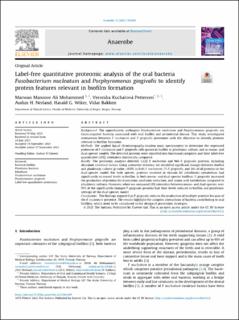Label-free quantitative proteomic analysis of the oral bacteria Fusobacterium nucleatum and Porphyromonas gingivalis to identify protein features relevant in biofilm formation
Journal article, Peer reviewed
Published version

Åpne
Permanent lenke
https://hdl.handle.net/11250/2991687Utgivelsesdato
2021Metadata
Vis full innførselSamlinger
- Department of Clinical Science [2318]
- Registrations from Cristin [9791]
Sammendrag
Background
The opportunistic pathogens Fusobacterium nucleatum and Porphyromonas gingivalis are Gram-negative bacteria associated with oral biofilm and periodontal disease. This study investigated interactions between F. nucleatum and P. gingivalis proteomes with the objective to identify proteins relevant in biofilm formation.
Methods
We applied liquid chromatography-tandem mass spectrometry to determine the expressed proteome of F. nucleatum and P. gingivalis cells grown in biofilm or planktonic culture, and as mono- and dual-species models. The detected proteins were classified into functional categories and their label-free quantitative (LFQ) intensities statistically compared.
Results
The proteomic analyses detected 1,322 F. nucleatum and 966 P. gingivalis proteins, including abundant virulence factors. Using univariate statistics, we identified significant changes between biofilm and planktonic culture (p-value ≤0.05) in 0,4% F. nucleatum, 7% P. gingivalis, and 14% of all proteins in the dual-species model. For both species, proteins involved in vitamin B2 (riboflavin) metabolism had significantly increased levels in biofilm. In both mono- and dual-species biofilms, P. gingivalis increased the production of proteins for translation, oxidation-reduction, and amino acid metabolism compared to planktonic cultures. However, when we compared LFQ intensities between mono- and dual-species, over 90% of the significantly changed P. gingivalis proteins had their levels reduced in biofilm and planktonic settings of the dual-species model.
Conclusions
The findings suggest that P. gingivalis reduces the production of multiple proteins because of the F. nucleatum presence. The results highlight the complex interactions of bacteria contributing to oral biofilms, which need to be considered in the design of prevention strategies.
